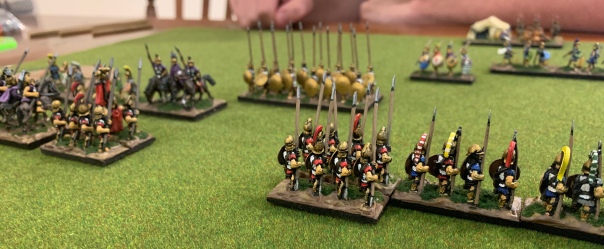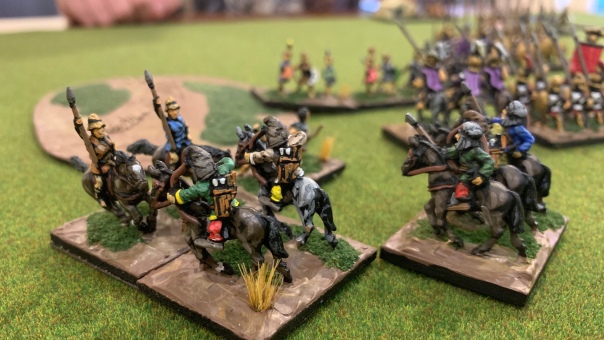Since the death of Alexander a number of his generals had been locked in deadly campaigns each attempting to decide the future of Alexander’s legacy. Two, of these were Peucestas and Lysimachus. Each had recruited armies and despite having a similar core, built around the Macedonian phalanx, differed in several areas.
Peucestas phalanx was bolstered by a strong contingent of mercenary hoplites that ensured superiority in the open against Lysimachus’ army which, though having a similar sized phalanx, lacked the quantity of heavy mercenaries. Instead Lysimachus had recruited a range of lightly armed infantry more suited to broken ground. While both armies comprised xystophoroi and light cavalry, Peucestas supplemented them with a considerable number of eastern heavy cavalry.
Determined to destroy Lysimachus in battle Peucestas had selected a battlefield that he hoped would favour him rather than his devious opponent. The battlefield he selected was relatively open with two gentle hills breaking up what was otherwise a featureless plain. Peucestas planned his main attack with his centre while his mounted would protect his left flank and his light troops the right. Lysimachus however, having seen his enemy deployed, extended his own right and was clearly determined to attack Peucestas’ left.
Lysimachus quickly seized the initiative and advanced rapidly against Peucestas’s left . Peucestas now undertook a realignment moving his centre some distance to the left. In the process of undertaking this complex manoeuvre a significant gap opened in Peucestas line.

Above, the massive gap in Peucestas’ line while below his cavalry engaged on his left flank.

Attempting to exploit this Lysimachus charged forward against Peucestas phalanx at the head of his own xystophoroi, supported by his phalanx.

Alas, in the resulting melee Lysimachus was badly wounded and the attack faltered. Now as Lysimachus was carried from the field Peucestas phalanx pressed forward. Victory was clearly now within Peucestas grasp.
Unfortunately Peucestas left was under pressure and despite his cavalry having the advantage against the Lysimachid light infantry, his eastern cavalry broke. Now Peucestas, at the very moment of victory, was enveloped by enemy light infantry. In the ensuing melee, at the head of his own xystophori, Peucestas was wounded and like his opponent carried from the field.

Above, Peucestas is engaged in the flank and from the front by peltasts and psiloi.
Tragically it was too much for Peucestas veterans who now fell back, surrendering the field to the Lysimachids. Fortunately, their enemy was almost exhausted and leaderless. As such they made no attempt to pursue, thus allowing the bulk of Peucestas army to retire in good order.
Several weeks now passed until both commanders recovered. Both determined to face each other again. Peucestas again selected an open plain. Again he deployed his light troops on his right and massed all his cavalry opposite Lysimachus mounted on his left.
Again the armies advanced towards each other. Initially Lysimachus’ left was most aggressive, a reverse of the previous engagement. Below, Lysimachus peltasts are visible on the right.

However, Lysimachus soon realised that a number of his peltasts would face Peucestas’ phalangites and ordered his advance to halt while he ordered forward his phalanx. The heavy foot of both armies closed for the fateful push of the phalanx. Again Lysimachus hesitated, while Peucestas’ veterans pressed forward driving portions of Lysimachus’s left flank back. Meanwhile, Peucestas mercenary hoplites on his left centre faced Lysimachus’ phalanx and Greek mercenaries. They awaited in well drilled ranks as their opponents moved forward. All soon were locked in combat.
The fateful decisions of the battle however occurred not in the centre but on each flank. Lysimachus right comprised both mounted and additional peltasts. The peltasts here were overwhelmed by Peucestas eastern cavalry, who had previously performed so badly in the proceeding battle. First Peucestas’ cavalry cut down the fleeing enemy foot then turned and engulfed Lysimachus xystophori, who were themselves engaged in a deadly melee against Peucestas’ own xystophori. Lysimachus was mortally wounded despite his personal bravery.

Above, the view of the deciding combat between Peucestas xystophori and this of Lysimachus.
Simultaneously, a body of Lysimachus’ peltasts gave way to Peucestas’ phalangites. As these peltasts routed they exposed the flank of Lysimachus’ phalanx which was now overwhelmed, being engaged to both front and rear.

Above, a view from Peucestas lines with a portion of the Lysimachid phalanx turned 90 degrees and attacked in the front and rear.
With Lysimachus now mortally wounded, and his army attacked on both flanks, it collapsed. Peucestas, had finally secured a decisive victory and with it his hold on his fledgling empire.